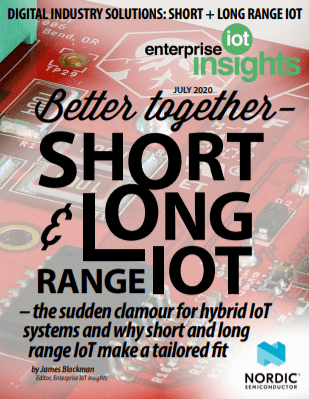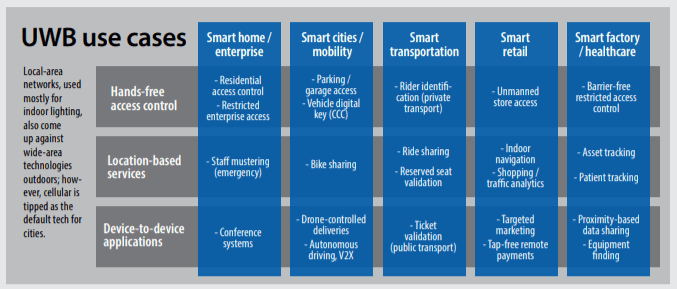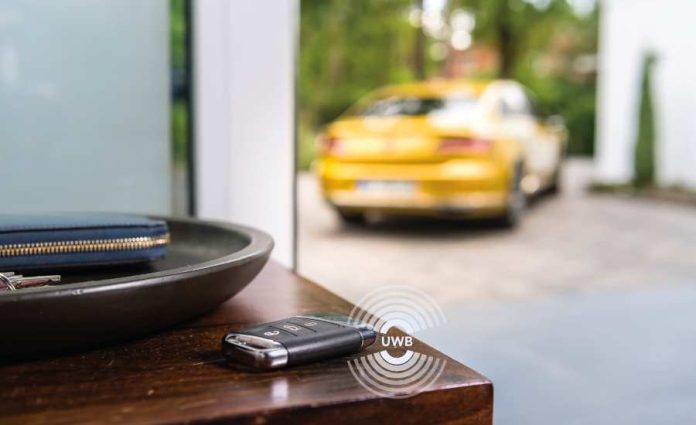Note, this article is taken from a new Enterprise IoT Insights editorial report, out tomorrow, on the combination of low-power short- and long-range communications technologies in hybrid IoT systems (see cover image below). Check back here for the full report (from July 9); a webinar on the same subject, including panellists from ABI Research, the Bluetooth SIG, and Nordic Semiconductor, among others, is scheduled for July 9, also. Register here to attend the webinar.
The latest rush of iPhones, at the end of 2019, was notable in IoT circles for the inclusion of a particular technology in its U1 chip: ultra wideband (UWB), based on the IEEE 802.15.4 standard. It was the first time UWB, a one-time competitor of Wi-Fi and some-time facility for military surveillance, had featured in everyday smartphones. The market took notice, naturally. “UWB is the new player in town,” notes a spokesperson at Nordic Semiconductor.
UWB uses wide spectrum (500 MHz to several GHz) and high frequency (between 6.5 GHz and 9 GHz), at a remove from the busy ISM band at 2.4 GHz. The technology has evolved since its early incarnation as a rival to Wi-Fi into something quite different, going from an orthogonal frequency-division multiplexing (OFDM) protocol for high data-rate communications to an impulse-based ‘see-through-walls’ radar-imaging tech.
UWB enables granular low-power short range positioning (‘fine ranging’) of objects in three-dimensional space – to about 10 centimetres, from a distance of about 200 metres. As well as locating objects with high precision, it can track them using distance measurements between radios, and calculate time arrival and angle of movement. Apple says it possesses ‘spatial awareness’.
 The FiRa (fine-ranging) Consortium, whose members include major smartphone makers, module makers and machine makers (Bosch, NXP, Samsung, STMicroelectronics et al), says UWB outperforms other short-range technologies in terms of accuracy, reliability, and power consumption – “by a wide margin”.
The FiRa (fine-ranging) Consortium, whose members include major smartphone makers, module makers and machine makers (Bosch, NXP, Samsung, STMicroelectronics et al), says UWB outperforms other short-range technologies in terms of accuracy, reliability, and power consumption – “by a wide margin”.
Ranging is achieved by time-of-flight (ToF) measurements of radar signals between devices. The process uses a large channel and short pulses, of about two nanoseconds each – issued 200-1,000 times per second. It makes location finding a real-time function. A UWB-enabled system is more resistant to interference, says the consortium, on the grounds UWB pulses resist ‘multi-path effect’, where signals reach the receiver by more than one path due to reflection or refraction, and are immune to fading and jamming.
Security is higher, too. A key addition to UWB with the incoming 802.15.4z specification is an extra portion of the physical layer (PHY), used to send and receive data packets, which adds cryptography, random number generation, and other techniques to make it harder to attack or manipulate UWB systems.
UWB use cases transfer easily into industrial IoT, and other sectors. The FiRa Consortium is developing specific protocols for multiple verticals and defining the necessary parameters for a range of applications, including physical access control, location-based services, device-to-device services, and others.

But UWB is being positioned as a complementary low-power technology, suited to a wide range of IoT applications demanding precision location measurement and proximity awareness. Nordic has just announced a deal with US semiconductor firm Qorvo to collaborate on dual-mode BLE and UWB modules.
A spokesperson says: “It doesn’t conflict with BLE. There is lots BLE can do that UWB can’t. It can be used to upload data encrypted to a local server; it does over-the-air updates; it brings mesh networking. It does all of these things, plus it is pretty accurate for indoor positioning. But it is rather like the last mile in fibre optics – UWB gives you that really rich, granular data, when you get closer to things.”
Indeed, the Bluetooth industry expects UWB to be commonly paired with BLE. Jim Katsandres, senior director of developer relations at the Bluetooth SIG, remarks: “Oftentimes it is complementary. There is usually a BLE radio in there, as well, to handle connections, and the UWB is used for high accuracy measurements to know exactly where a key fob is, or whatever. But it is a different type of technology.”
UWB offers direction of movement, as well; useful to determine if a device, whether a workstation or a door, should be locked or unlocked as a person approaches or leaves. The accuracy of UWB ranging allows use cases to define a precise ‘intent range’ to cascade instructions in a system without false triggering – so a garage door opens as a car approaches, followed by an internal door into the living quarters as the car pulls up.
But Katsandres notes the crossover between BLE and UWB for geolocation services in IoT applications, and draws attention to the latest 5.1 version of the Bluetooth specification, which brings more accurate positioning (“centimetre level, and even tighter with more radios”), and adds direction finding into the mix. “If you’re already using BLE, you will stick with that – just because of cost and optimisation,” he says.
Adarsh Krishnan, principal analyst at ABI Research, says the addition of UWB for positioning will take IoT tracking applications further, however, down to millimetre-level accuracy even. UWB will be paired with low-power wide-area (LPWA) IoT networking, as well, he says.
“The next thing could be UWB for millimetre level accuracy. We are already seeing individual devices using UWB in small form factors. There is nothing to say you won’t see it integrated with a wide-area technology like NB-IoT. It comes down to the cost, in the end.”
Albert Behr, founder and chief executive at BehrTech, champion of the novel telegram-splitting over ultra-narrowband (TSUNB) technique for LPWA communications, is not so sure. The jury is still out, he says, and will take a while to return. “Except for high-precision indoor positioning, UWB applications for IoT are not widely discussed and its potential remains largely under question.”


